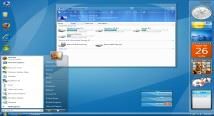Olympiad Test: MS Windows 7 - 1 - Class 6 MCQ
15 Questions MCQ Test - Olympiad Test: MS Windows 7 - 1
______ works as the primary interface between the computer and all programs running on a computer.
The time is shown in the ______ area on the taskbar.
To open a game like Minesweeper, click _____ > All programs > Games > Minesweeper.
When you copy a file, Windows places a duplicate copy of the file in the temporary store. The contents of that memory are lost when you shut down the computer. The temporary store used while copying is called ______.
Full multitasking is NOT provided by which of the following operating systems?
As soon as Windows starts up and you log in, you see the ______.
When you shut down your Windows operating system computer, it automatically clears the contents of ______.
You can display various toolbars on your taskbar by ______.
Which of the following is NOT a version of Windows Vista?
When Windows needs more information from you like confirmation to delete a file, the information is displayed in a ______.
To save energy, a computer for some time goes into the ______ mode.
______ are links to programs, documents, files or websites that you can add to your desktop or Start menu.
A snapshot of desktop is given. Which version of Windows it is most likely from?















